I am using the function "ps_venn" to compare taxa present in different samples with a phyloseq object. This function outputs a nested list of each sample(s) and the intersecting taxa:
Because this is metabarcoding data, the taxa have these long complicated names. I have a dataframe of the taxa lineages formatted like this:

I would like to rename the taxa in the list based on the name in the "class" column.
I have no experience with lists in R, so I'd appreciate any guidance. Thanks!
Edit: Here is the function I used on my phyloseq object:
cvenn.met <- ps_venn(combined_c, group = "method", weight = FALSE, plot = FALSE)
Here is the beginning of the output list:
list(OBB = c("329966c334544d14f9985b98b813f40f",
"8e1c87829579917f8f77f7fe7a30156a"
), OES = "2f86f2cb2e0879ebd39e60982959c8bd", QBB = c("9be3f72560b678f6bbd584632672818a",
"3a7f78f620f4733bf2344867beae26aa", "ca57149144a6a6dfdb6e14465d3e2123",
"8612ebe6094b2f7fd25985e5c0c36226", "5a3ed6459016f5c9398eab8f051940a0",
"c3f2f11de98c6f64740ea772e202bcbc"), QPP = "8d7b15445ca448bec893311b47510e00",
QPS = c("407465934116d64a8d61c12cee90b0b0", "768ed20a18290c921ed30f24e458e25a",
"b7a099fb2ea20e4a13fa7c52820eeb6c"), MIC__OBB__OES__OMT__QBB__QBT__QPP__QPS = c("74bda332d0a3174634f9b496b1da8d0c",
"cd9cac265a41b06843d41aaa1893efd5", "72e5af8afb3fdd3323fede4d49e97bda",
"d785682c0a83be9275e095d76cabbe36", "fd736d603728e963c8c47487a8e48755",
"875f4582d8e1dc661efbda0d8bb11c22", "b8615ae8b54a17ee118afe8718d7ee11"
))
Here is the beginning of my taxonomy dataframe:
structure(list(X = c("0021706b1ca315556a24b6d5df927e5b", "0038f2eedf8cc7893a7a9a4330aa477c",
"003ba56d29607b45d8599085b8b69afa", "004610d70fb6092436394ca4b09bf6fb",
"004af7f8f83f24fb7b51d8335583e14a", "0053fa60aebebf5f5e6008c70425230c"
), domain = c("Eukaryota", "Eukaryota", "Eukaryota", "Eukaryota",
"Eukaryota", "Eukaryota"), supergroup = c("Haptista", "TSAR",
"TSAR", "TSAR", "Obazoa", "Obazoa"), division = c("Haptophyta",
"Alveolata", "Rhizaria", "Alveolata", "Opisthokonta", "Opisthokonta"
), subdivision = c("Haptophyta_X", NA, "Radiolaria", "Dinoflagellata",
NA, "Metazoa"), class = c("Prymnesiophyceae", NA, "RAD-B", "Syndiniales",
NA, "Arthropoda"), order = c("Prymnesiales", NA, "RAD-B_X", "Dino-Group-II",
NA, "Crustacea"), family = c("Chrysochromulinaceae", NA, "RAD-B_X_Group-IVd",
"Dino-Group-II-Clade-2", NA, "Maxillopoda"), genus = c("Chrysochromulina",
NA, "RAD-B_X_Group-IVd_X", "Dino-Group-II-Clade-2_X", NA, NA),
species = c(NA_character_, NA_character_, NA_character_,
NA_character_, NA_character_, NA_character_), Consensus = c(0.625,
0.75, 0.714, 0.714, 1, 0.6)), row.names = c(NA, 6L), class = "data.frame")
I would like to rename the strings of text in my list with their corresponding taxonomy in the "class" column.
